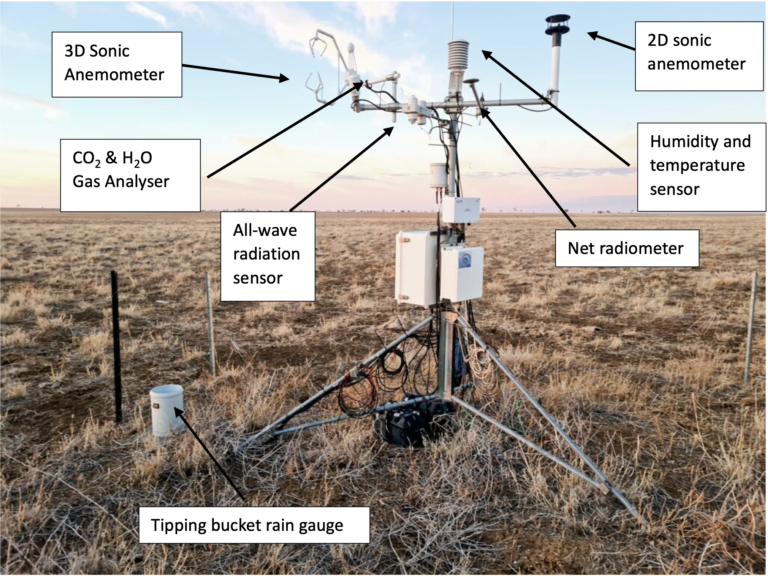An Eddy Covariance Flux Tower (‘Flux Tower’) continuously measures gas exchange between the land surface (soil and vegetation) and the atmosphere. It can continuously monitor greenhouse gas movement over extensive ranges, from hundreds of square meters to tens of square kilometres. Flux tower data let us track greenhouse gas regulation by ecosystems and find out how different land management practices affect emissions.
General principle
Firstly, there are a few definitions:
- A flux describes how much energy or mass moves through a unit area per unit time.
- An eddy is a rotating parcel of air that moves across the land surface.
- Covariance describes how two things change together.
Flux towers measure the vertical movement of greenhouse gases that are carried by eddies to/from the land surface. Over time, the concentration of greenhouse gases in eddies changes, which reveals the story of whether an ecosystem is acting as a source (releases more carbon than it absorbs) or a sink (absorbs more carbon than it releases).
Measuring the relationship (covariance) between gas concentration and the vertical wind speed is the general principle of how ‘eddy covariance’ flux towers work. For example, if at one moment the tower measures that 5 molecules of CO2 were pushed upwards by an eddy, and in the next moment only 3 molecules were brought back down, then there would be a net flux upwards of 2 molecules of CO2.

How flux towers can help inform soil carbon storage
Flux towers measure Net Ecosystem Exchange (NEE) of carbon dioxide. NEE is the technical term to describe the sum of the vertical CO2 fluxes in an ecosystem over time. NEE can also be described as the balance between plant photosynthesis, which causes CO2 uptake by ecosystems, and ‘ecosystem respiration’, which causes CO2 release by ecosystems.
What is ecosystem respiration? This is the total amount of CO2 released from living organisms (plant and animal) in an ecosystem. We are particularly interested in soil respiration, which occurs when organic matter in the soil (dead leaves, roots etc) is decomposed by soil microorganisms.
As soil microbes consume organic matter, they help add carbon to the soil. So, for soil carbon to increase, an ecosystem needs to produce enough biomass through photosynthesis to support a healthy soil microbiome. Flux towers provide a measure of how much carbon dioxide has been taken up by an ecosystem and how it changes over time. With additional measurements of soil respiration, biomass and modelling, the amount of carbon stored in vegetation be accounted for and subtracted from flux tower NEE. The remaining portion can be used to infer soil carbon stores.








